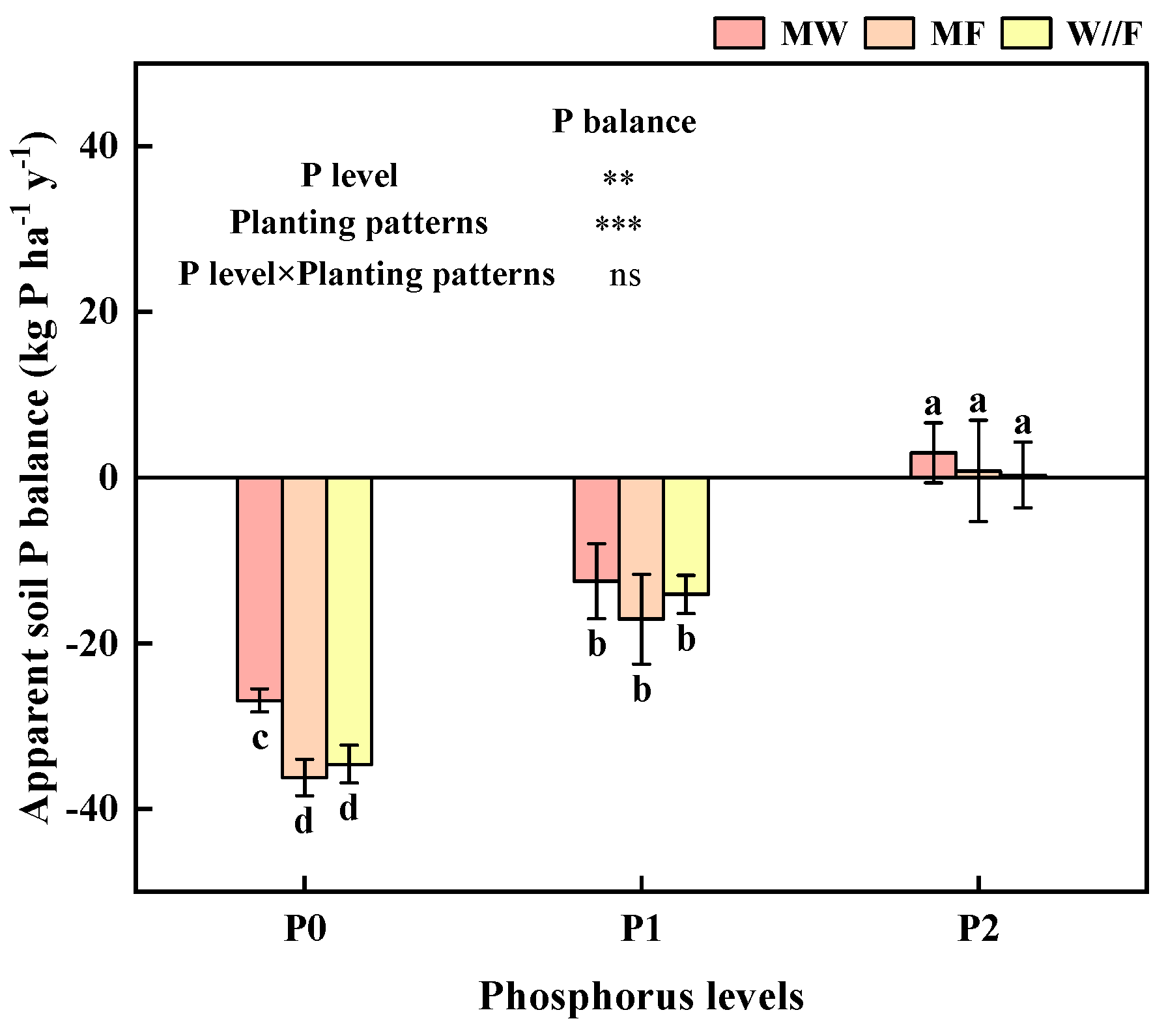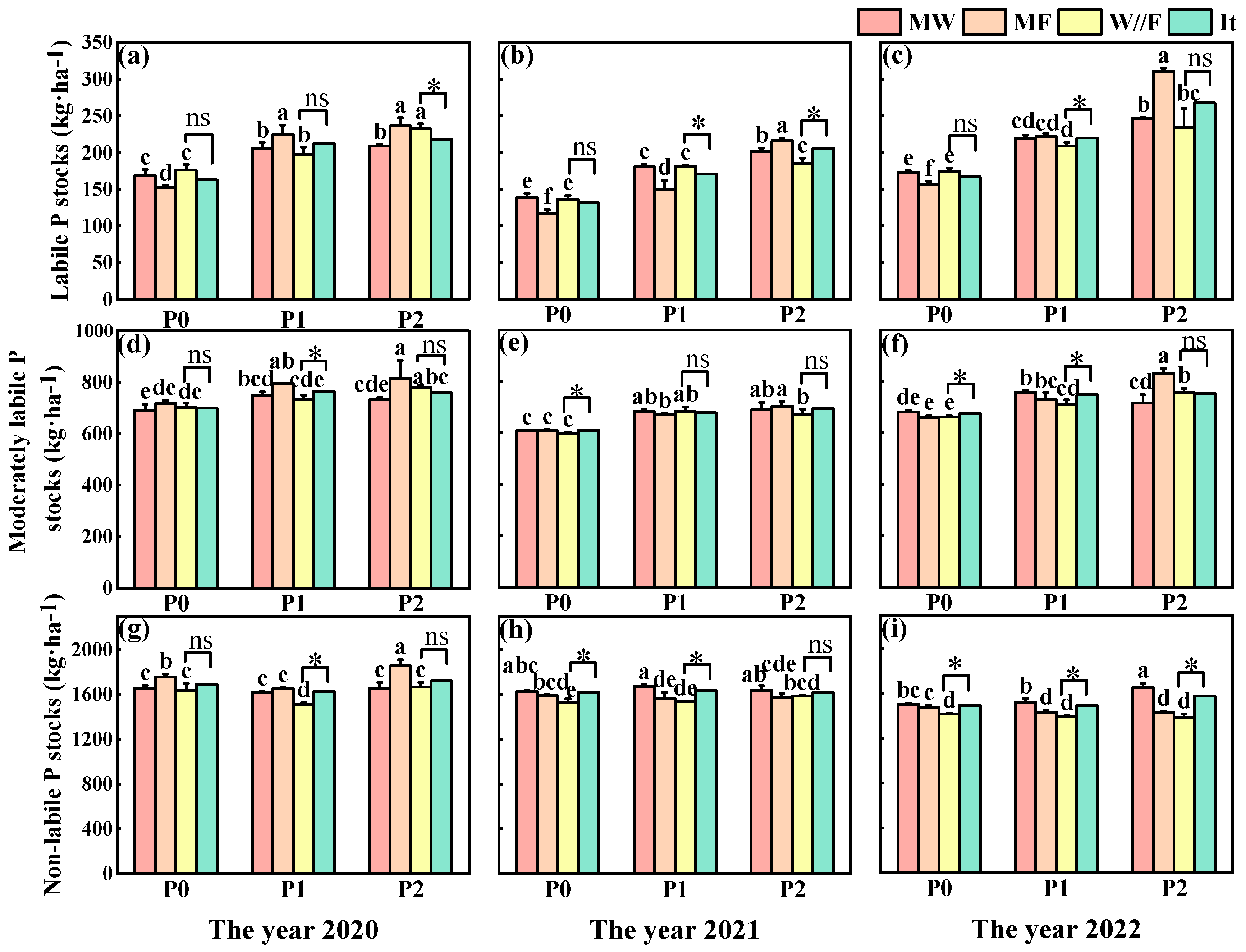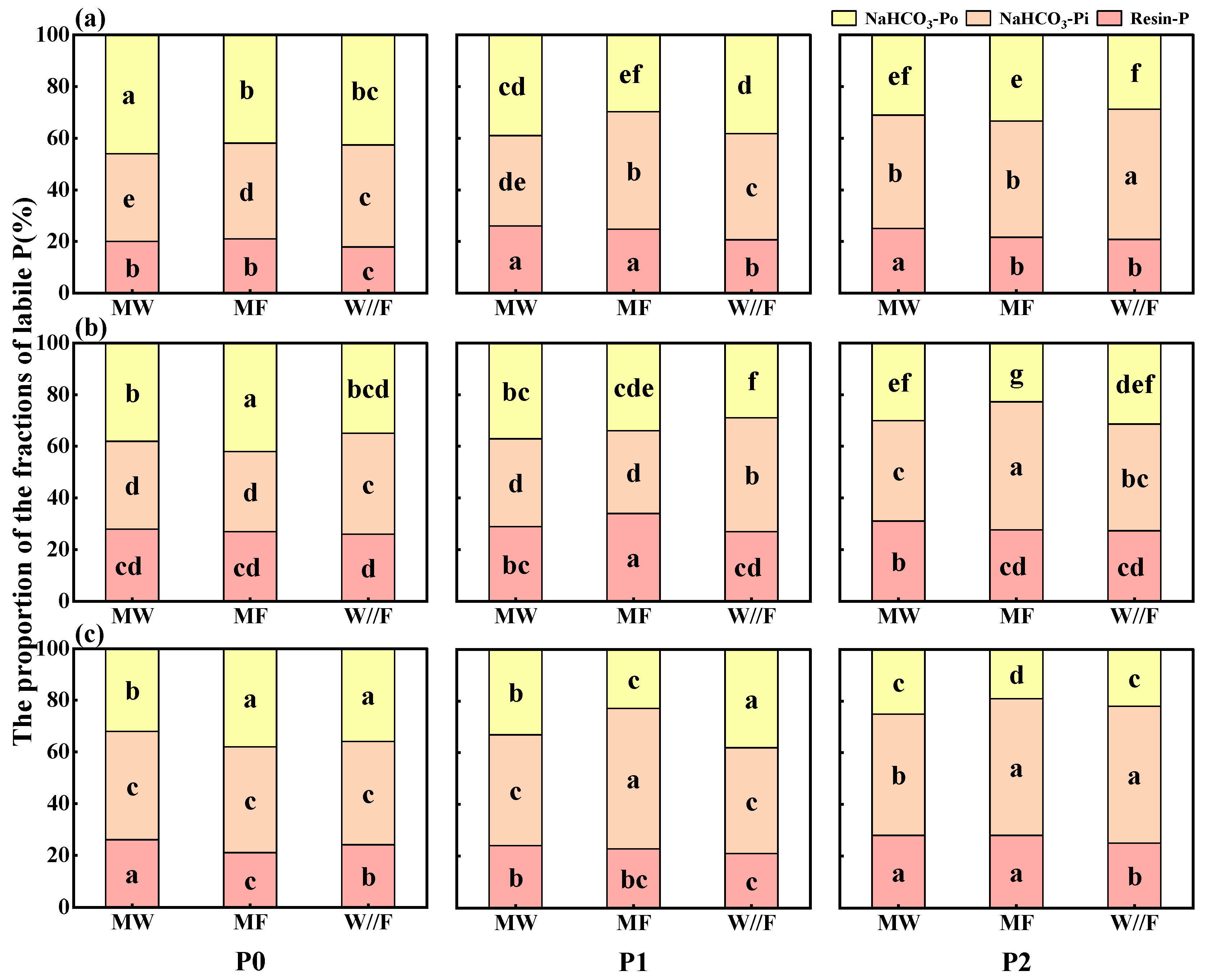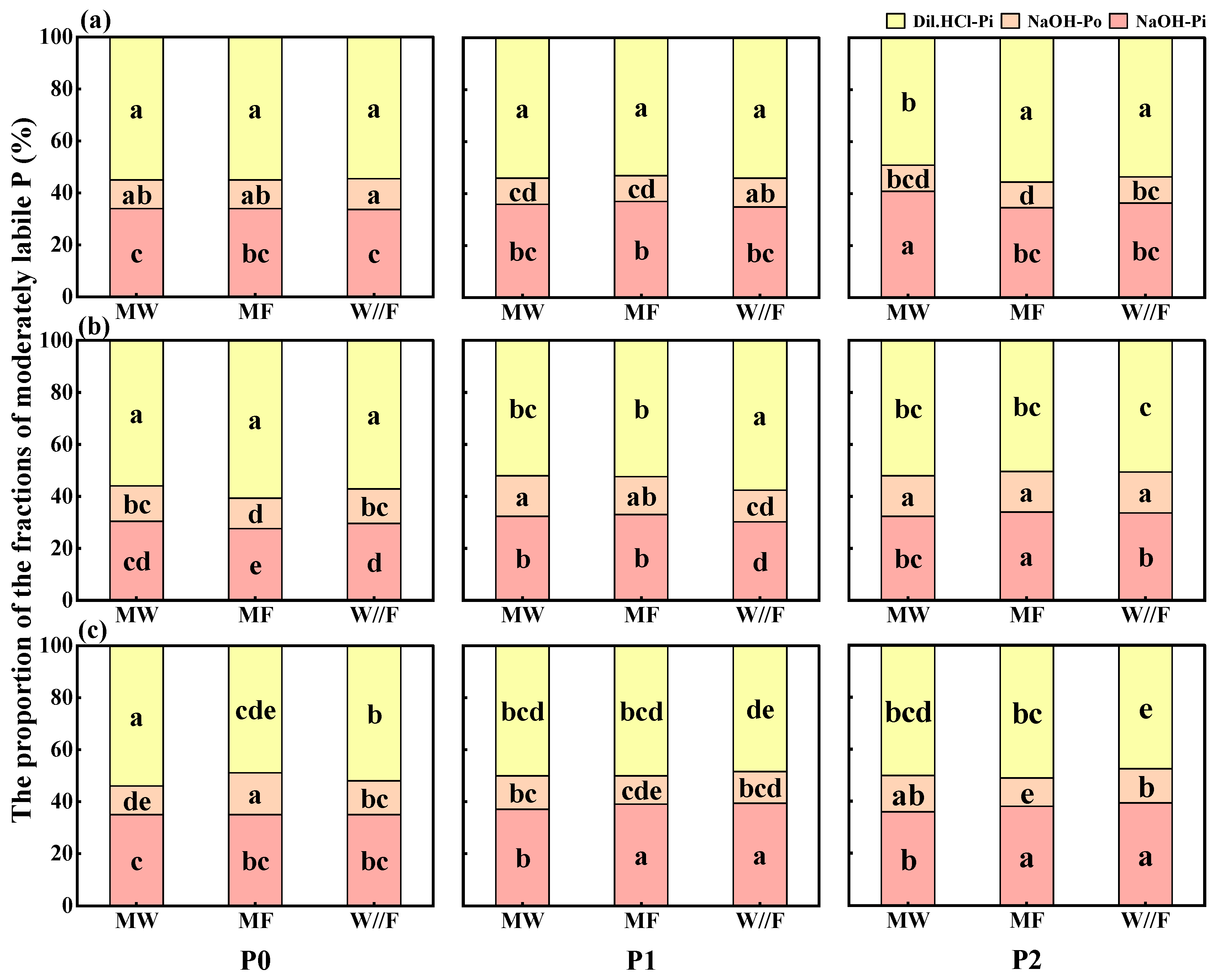Continuous Intercropping Increases the Depletion of Soil Available and Non-Labile Phosphorus
Abstract
1. Introduction
2. Materials and Methods
2.1. Field Site
2.2. Experimental Design
2.3. Field Management
2.4. Sample Collection and Determination
2.5. Data Collection
2.6. Statistical Analysis
3. Results
3.1. Crop P Uptake and Apparent Soil P Balance
3.2. Soil Available P Stock
3.3. Soil P Pool
3.3.1. Labile P Pool
3.3.2. Moderately Labile P Pool
3.3.3. Non-Labile P Pool
3.4. Proportions of Different P Fractions in the Soil
3.5. Co-Relationship among Crop P Uptake, Soil Available P, and Soil P Fractions
4. Discussion
4.1. Effects of Continuous Cereal and Legume Intercropping on the Soil P Pool
4.2. Effects of Cereal and Legume Intercropping on Soil Labile P Fractions
4.3. Effects of Cereal and Legume Intercropping on Moderately Labile and Non-Labile P Fractions in Soil
4.4. Interrelationship between Crop P Uptake and the P Fraction
5. Conclusions
Supplementary Materials
Author Contributions
Funding
Data Availability Statement
Conflicts of Interest
References
- Dissanayaka, D.M.S.B.; Maruyama, H.; Masuda, G.; Wasaki, J. Interspecific facilitation of P acquisition in intercropping of maize with white lupin in two contrasting soils as influenced by different rates and forms of P supply. Plant Soil 2015, 390, 223–236. [Google Scholar] [CrossRef]
- Gao, Y.; Wang, X.; Shah, J.A.; Chu, G. Polyphosphate fertilizers increased maize (Zea mays L.) P, Fe, Zn, and Mn uptake by decreasing P fixation and mobilizing microelements in calcareous soil. J. Soils Sediments 2020, 20, 1–11. [Google Scholar] [CrossRef]
- MacDonald, G.K.; Bennett, E.M.; Potter, P.A.; Ramankutty, N. Agronomic phosphorus imbalances across the world’s croplands. Proc. Natl. Acad. Sci. USA 2011, 108, 3086–3091. [Google Scholar] [CrossRef] [PubMed]
- Sattari, S.Z.; Bouwman, A.F.; Giller, K.E.; van Ittersum, M.K. Residual soil phosphorus as the missing piece in the global phosphorus crisis puzzle. Proc. Natl. Acad. Sci. USA 2012, 109, 6348–6353. [Google Scholar] [CrossRef] [PubMed]
- Dawson, C.; Hilton, J. Fertiliser availability in a resource-limited world: Production and recycling of nitrogen and phosphorus. Food Policy 2011, 36, S14–S22. [Google Scholar] [CrossRef]
- Hinsinger, P.; Betencourt, E.; Bernard, L.; Brauman, A.; Plassard, C.; Shen, J.; Tang, X.; Zhang, F. P for Two, Sharing a Scarce Resource: Soil Phosphorus Acquisition in the Rhizosphere of Intercropped Species. Plant Physiol. 2011, 156, 1078–1086. [Google Scholar] [CrossRef] [PubMed]
- Li, H.; Huang, G.; Meng, Q.; Ma, L.; Yuan, L.; Wang, F.; Zhang, W.; Cui, Z.; Shen, J.; Chen, X.; et al. Integrated soil and plant phosphorus management for crop and environment in China. A review. Plant Soil 2011, 349, 157–167. [Google Scholar] [CrossRef]
- Li, Y.; Gao, R.; Yang, R.; Wei, Y.; Li, Y.; Xiao, H.; Wu, J. Using a Simple Soil Column Method to Evaluate Soil Phosphorus Leaching Risk. CLEAN—Soil Air Water 2013, 41, 1100–1107. [Google Scholar] [CrossRef]
- Bruulsema, T.W.; Peterson, H.M.; Prochnow, L.I. The Science of 4R Nutrient Stewardship for Phosphorus Management across Latitudes. J. Environ. Qual. 2019, 48, 1295–1299. [Google Scholar] [CrossRef]
- Shen, J.; Yuan, L.; Zhang, J.; Li, H.; Bai, Z.; Chen, X.; Zhang, W.; Zhang, F. Phosphorus Dynamics: From Soil to Plant. Plant Physiol. 2011, 156, 997–1005. [Google Scholar] [CrossRef]
- He, Y.; Ding, N.; Shi, J.; Wu, M.; Liao, H.; Xu, J. Profiling of microbial PLFAs: Implications for interspecific interactions due to intercropping which increase phosphorus uptake in phosphorus limited acidic soils. Soil Biol. Biochem. 2013, 57, 625–634. [Google Scholar] [CrossRef]
- Li, H.; Zhang, F.; Rengel, Z.; Shen, J. Rhizosphere properties in monocropping and intercropping systems between faba bean (Vicia faba L.) and maize (Zea mays L.) grown in a calcareous soil. Crop. Pasture Sci. 2013, 64, 976–984. [Google Scholar] [CrossRef]
- Darch, T.; Giles, C.D.; Blackwell, M.S.; George, T.S.; Brown, L.K.; Menezes-Blackburn, D.; Shand, C.A.; Stutter, M.I.; Lumsdon, D.G.; Mezeli, M.M. Inter-and intra-species intercropping of barley cultivars and legume species, as affected by soil phosphorus availability. Plant Soil 2018, 427, 125–138. [Google Scholar] [CrossRef]
- Li, L.; Tilman, D.; Lambers, H.; Zhang, F. Plant diversity and overyielding: Insights from belowground facilitation of intercropping in agriculture. New Phytol. 2014, 203, 63–69. [Google Scholar] [CrossRef] [PubMed]
- Niederberger, J.; Kohler, M.; Bauhus, J. Distribution of phosphorus fractions with different plant availability in German forest soils and their relationship with common soil properties and foliar P contents. SOIL 2019, 5, 189–204. [Google Scholar] [CrossRef]
- Dissanayaka, D.M.S.B.; Wickramasinghe, W.M.K.R.; Marambe, B.; Wasaki, J.U.N. Phosphorus-mobilization strategy based on carboxylate exudation in lupin (Lupinus, Fabaceae): A mechanism facilitating the growth and phopsphorus acquisition of neighboring plants under phosphorus-limited conditions. Exp. Agric 2017, 53, 308–319. [Google Scholar] [CrossRef]
- Latati, M.; Blavet, D.; Alkama, N.; Laoufi, H.; Drevon, J.J.; Gérard, F.; Pansu, M.; Ounane, S.M. The intercropping cowpea-maize improves soil phosphorus availability and maize yields in an alkaline soil. Plant Soil 2014, 385, 181–191. [Google Scholar] [CrossRef]
- Betencourt, E.; Duputel, M.; Colomb, B.; Desclaux, D.; Hinsinger, P. Intercropping promotes the ability of durum wheat and chickpea to increase rhizosphere phosphorus availability in a low P soil. Soil Biol. Biochem. 2012, 46, 181–190. [Google Scholar] [CrossRef]
- O’sullivan, J.B.; Jin, J.; Tang, C. Elevated CO2 promotes the acquisition of phosphorus in crop species differing in physiological phosphorus-acquiring mechanisms. Plant Soil 2020, 455, 397–408. [Google Scholar] [CrossRef]
- Ziadi, N.; Whalen, J.K.; Messiga, A.J.; Morel, C. Assessment and Modeling of Soil Available Phosphorus in Sustainable Cropping Systems. Adv. Agron 2013, 122, 85–126. [Google Scholar]
- Hedley, M.J.; Stewart, J.; Chauhan, B.S. Changes in Inorganic and Organic Soil Phosphorus Fractions Induced by Cultivation Practices and by Laboratory Incubations. Soil Sci. Soc. Am. J. 1982, 46, 970–976. [Google Scholar] [CrossRef]
- Yonathan, R.; Siobhan, S.; Paola, D.; Liliana, G.; Cornelia, R.; María de la Luz, M. Fertilizer P Uptake Determined by Soil P Fractionation and Phosphatase Activity. J. Soil Sci. Plant Nutr. 2019, 19, 166–174. [Google Scholar]
- Liu, J.; Yang, J.; Cade-Menun, B.J.; Liang, X.; Hu, Y.; Liu, C.W.; Zhao, Y.; Li, L.; Shi, J. Complementary phosphorus speciation in agricultural soils by sequential fractionation, solution 31P nuclear magnetic resonance, and phosphorus K-edge X-ray absorption near-edge structure spectroscopy. J. Environ. Qual. 2013, 42, 1763–1770. [Google Scholar] [CrossRef]
- Bol, R.; Julich, D.; Brödlin, D.; Siemens, J.; Kaiser, K.; Dippold, M.A.; Spielvogel, S.; Zilla, T.; Mewes, D.; von Blanckenburg, F.; et al. Dissolved and colloidal phosphorus fluxes in forest ecosystems—An almost blind spot in ecosystem research. J. Soil Sci. Plant Nutr. 2016, 179, 425–438. [Google Scholar] [CrossRef]
- Cabeza, R.A.; Myint, K.; Steingrobe, B.; Stritsis, C.; Schulze, J.; Claassen, N. Phosphorus fractions depletion in the rhizosphere of young and adult maize and oilseed rape plants. J. Soil Sci. Plant Nutr. 2017, 17, 824–838. [Google Scholar] [CrossRef]
- Rubio, G.; Faggioli, V.; Scheiner, J.D.; Gutiérrez-Boem, F.H. Rhizosphere phosphorus depletion by three crops differing in their phosphorus critical levels. J. Plant Nutr. 2012, 175, 810–871. [Google Scholar] [CrossRef]
- Liao, D.; Zhang, C.; Lambers, H.; Zhang, F. Changes in soil phosphorus fractions in response to long-term phosphate fertilization under sole cropping and intercropping of maize and faba bean on a calcareous soil. Plant Soil 2021, 463, 589–600. [Google Scholar] [CrossRef]
- Yang, Z.; Zhang, Y.; Wang, Y.; Zhang, H.; Zhu, Q.; Yan, B.; Fei, J.; Xiangmin, R.; Peng, J.; Luo, G. Intercropping regulation of soil phosphorus composition and microbially-driven dynamics facilitates maize phosphorus uptake and productivity improvement. Field Crop. Res. 2022, 287, 108666. [Google Scholar] [CrossRef]
- Presti, E.L.; Badagliacca, G.; Romeo, M.; Monti, M. Does Legume Root Exudation Facilitate Itself P Uptake in Intercropped Wheat? J. Soil Sci. Plant Nutr. 2021, 21, 3269–3283. [Google Scholar] [CrossRef]
- Zhu, Y.-A.; He, J.; Yu, Z.; Zhou, D.; Li, H.; Wu, X.; Dong, Y.; Tang, L.; Zheng, Y.; Xiao, J. Wheat and Faba Bean Intercropping Together with Nitrogen Modulation Is a Good Option for Balancing the Trade-Off Relationship between Grain Yield and Quality in the Southwest of China. Agronomy 2022, 12, 2984. [Google Scholar] [CrossRef]
- Wright, A.L.; Hons, F.M.; Lemon, R.G.; McFarland, M.L.; Nichols, R.L. Microbial activity and soil C sequestration for reduced and conventional tillage cotton. Appl. Soil Ecol. 2008, 38, 168–173. [Google Scholar] [CrossRef]
- Ding, L.; Wu, J.; Xiao, H.; Zhou, P.; Syers, J.K. Mobilisation of inorganic phosphorus induced by rice straw in aggregates of a highly weathered upland soil. J. Sci. Food Agric. 2012, 92, 1073–1079. [Google Scholar] [CrossRef] [PubMed]
- Xu, B.; Xu, W.; Wang, Z.; Chen, Z.; Palta, J.A.; Chen, Y. Accumulation of N and P in the legume Lespedeza davurica in controlled mixtures with the grass Bothriochloa ischaemum under varying water and fertilization conditions. Front. Plant Sci. 2018, 9, 165. [Google Scholar] [CrossRef] [PubMed]
- Suzuki, L.E.A.S.; Reinert, D.J.; Fenner, P.T.; Secco, D.; Reichert, J.M. Prevention of additional compaction in eucalyptus and pasture land uses, considering soil moisture and bulk density. J. South Am. Earth Sci. 2022, 120, 104113. [Google Scholar] [CrossRef]
- Watanabe, F.S.; Olsen, S.R. Test of an Ascorbic Acid Method for Determining Phosphorus in Water and NaHCO3 Extracts from Soil. Soil Sci. Soc. Am. J. 1965, 29, 677–678. [Google Scholar] [CrossRef]
- Murphy, J.A.; Riley, J.P. A modified single solution method for the determination of phosphate in natural waters. Anal. Chim. Acta 1962, 27, 678–681. [Google Scholar] [CrossRef]
- Moir, J.; Tiessen, H. Characterization of Available P by Sequential Extraction. In Soil Sampling and Methods of Analysis; Informa UK Limited: London, UK, 1993; Volume 7, pp. 5–229. [Google Scholar]
- Shi, L.-L.; Shen, M.-X.; Lu, C.-Y.; Wang, H.-H.; Zhou, X.-W.; Jin, M.-J.; Wu, T.-D. Soil phosphorus dynamic, balance and critical P values in long-term fertilization experiment in Taihu Lake region, China. J. Integr. Agric. 2015, 14, 2446–2455. [Google Scholar] [CrossRef]
- Rao, M.R.; Willey, R.W. Evaluation of yield stability in intercropping: Studies on Sorghum/Pigeonpea. Exp. Agric. 1980, 16, 105–116. [Google Scholar] [CrossRef]
- Zamuner, E.C.; Díez, A.B.; Picone, L.I. Effect of long-term phosphorus fertilization on soil phosphorus fractions. Span. J. Soil Sci. 2012, 2, 50–61. [Google Scholar] [CrossRef]
- Tang, X.; Xia, M.; Guan, F.; Fan, S. Spatial Distribution of Soil Nitrogen, Phosphorus and Potassium Stocks in Moso Bamboo Forests in Subtropical China. Forests 2016, 7, 267. [Google Scholar] [CrossRef]
- Rosseel, Y.; Loh, W.W. A structural after measurement approach to structural equation modeling. Psychol. Methods 2022. [Google Scholar] [CrossRef] [PubMed]
- Mndzebele, B.; Ncube, B.; Fessehazion, M.; Mabhaudhi, T.; Amoo, S.; du Plooy, C.; Venter, S.; Modi, A. Effects of cowpea-amaranth intercropping and fertiliser application on soil phosphatase activities, available soil phosphorus, and crop growth response. Agronomy 2020, 10, 79. [Google Scholar] [CrossRef]
- Wang, B.; Liu, H.; Wang, X.H.; Li, J.M.; Ma, Y.B.; Ma, X.W. Soil phosphorus accumulation model for an arid area of north-western China with 3-year rotation of wheat, maize and cotton. J. Agric. Sci. 2015, 153, 1247–1256. [Google Scholar] [CrossRef]
- An, R.; Yu, R.-P.; Xing, Y.; Zhang, J.-D.; Bao, X.-G.; Lambers, H.; Li, L. Intercropping efficiently utilizes phosphorus resource in soil via different strategies mediated by crop traits and species combination. Plant Soil 2023, 497, 705–725. [Google Scholar] [CrossRef]
- Li, S.M.; Li, L.; Zhang, F.S.; Tang, C. Acid Phosphatase Role in Chickpea/Maize Intercropping. Ann. Bot. 2004, 94, 297–303. [Google Scholar] [CrossRef]
- Xiao, L.; Chen, G.; Wang, H.; Li, Y.; Li, C.; Cheng, L.; Wenge, W.; Xiao, X.; Zhu, Y. Improvement of P use efficiency and P balance of rice-wheat rotation system according to the long term field experiments in the Yangze River Delta. Front. Environ. Sci. 2022, 10, 979. [Google Scholar] [CrossRef]
- Bowman, R.A.; Cole, C.V. Transformations of organic phosphorus substrates in soils as evaluated by NaHCO3 extraction. Soil Sci. 1978, 125, 49–54. [Google Scholar] [CrossRef]
- Yang, X.; Post, W.M. Phosphorus transformations as a function of pedogenesis: A synthesis of soil phosphorus data using Hedley fractionation method. Biogeosciences 2011, 8, 2907–2916. [Google Scholar] [CrossRef]
- Gao, X.; Shi, D.; Lv, A.; Wang, S.; Yuan, S.; Zhou, P.; An, Y. Increase phosphorus availability from the use of alfalfa (Medicago sativa L.) green manure in rice (Oryza sativa L.) agroecosystem. Sci. Rep. 2016, 6, 36981. [Google Scholar] [CrossRef]
- Sharpley, A.N. Phosphorus Cycling in Unfertilized and Fertilized Agricultural Soils. Soil Sci. Soc. Am. J. 1985, 49, 905–911. [Google Scholar] [CrossRef]
- Zhou, L.; Su, L.; Zhao, H.; Wang, S.; Zheng, Y.; Tang, L. Maize/soybean intercropping promoted activation of soil organic phosphorus fractions by enhancing more phosphatase activity in red soil under different phosphorus application rates. Plant Soil 2023, 1–20. [Google Scholar] [CrossRef]
- Liao, D.; Zhang, C.; Lambers, H.; Zhang, F. Adding intercropped maize and faba bean root residues increases phosphorus bioavailability in a calcareous soil due to organic phosphorus mineralization. Plant Soil 2022, 476, 201–218. [Google Scholar] [CrossRef]
- Granzow, S.; Kaiser, K.; Wemheuer, B.; Pfeiffer, B.; Daniel, R.; Vidal, S.; Wemheuer, F. The effects of cropping regimes on fungal and bacterial communities of wheat and faba bean in a greenhouse pot experiment differ between plant species and compartment. Front. Microbiol. 2017, 8, 216435. [Google Scholar] [CrossRef] [PubMed]
- Li, H.; Shen, J.; Zhang, F.; Clairotte, M.; Drevon, J.J.; Le Cadre, E.; Hinsinger, P. Dynamics of phosphorus fractions in the rhizosphere of common bean (Phaseolus vulgaris L.) and durum wheat (Triticum turgidum durum L.) grown in monocropping and intercropping systems. Plant Soil 2008, 312, 139–150. [Google Scholar] [CrossRef]
- Liu, Y.; Zhang, G.; Luo, X.; Hou, E.; Zheng, M.; Zhang, L.; He, X.; Shen, W.; Wen, D. Mycorrhizal fungi and phosphatase involvement in rhizosphere phosphorus transformations improves plant nutrition during subtropical forest succession. Soil Biol. Biochem. 2021, 153, 108099. [Google Scholar] [CrossRef]
- Zhu, Y.; Wu, F.; He, Z.; Guo, J.; Qu, X.; Xie, F.; Giesy, J.P.; Liao, H.; Guo, F. Characterization of Organic Phosphorus in Lake Sediments by Sequential Fractionation and Enzymatic Hydrolysis. Environ. Sci. Technol. 2013, 47, 7679–7687. [Google Scholar] [CrossRef] [PubMed]
- Li, G.; Li, H.; Leffelaar, P.A.; Shen, J.; Zhang, F. Dynamics of phosphorus fractions in the rhizosphere of fababean (Vicia faba L.) and maize (Zea mays L.) grown in calcareous and acid soils. Crop. Pasture Sci. 2015, 66, 1151–1160. [Google Scholar] [CrossRef]
- Liao, D.; Zhang, C.; Li, H.; Lambers, H.; Zhang, F. Changes in soil phosphorus fractions following sole cropped and intercropped maize and faba bean grown on calcareous soil. Plant Soil 2020, 448, 587–601. [Google Scholar] [CrossRef]
- Cross, A.F.; Schlesinger, W.H. A literature review and evaluation of the. Hedley fractionation: Applications to the biogeochemical cycle of soil phosphorus in natural ecosystems. Geoderma 1995, 64, 197–214. [Google Scholar] [CrossRef]
- Hinsinger, P. Bioavailability of soil inorganic P in the rhizosphere as affected by root-induced chemical changes: A review. Plant Soil 2001, 237, 173–195. [Google Scholar] [CrossRef]
- Duchene, O.; Vian, J.-F.; Celette, F. Intercropping with legume for agroecological cropping systems: Complementarity and facilitation processes and the importance of soil microorganisms. A review. Agric. Ecosyst. Environ. 2017, 240, 148–161. [Google Scholar] [CrossRef]
- Wang, Y.; Zhang, W.; Müller, T.; Lakshmanan, P.; Liu, Y.; Liang, T.; Wang, L.; Yang, H.; Chen, X. The distribution of phosphorus from recycled fertilizers to different soil fractions determines the phosphorus availability in soil. SOIL 2021, 2021, 1–26. [Google Scholar]
- Hou, E.; Chen, C.; Kuang, Y.; Zhang, Y.; Heenan, M.; Wen, D. A structural equation model analysis of phosphorus transformations in global unfertilized and uncultivated soils. Glob. Biogeochem. Cycles 2016, 30, 1300–1309. [Google Scholar] [CrossRef]
 soil sampling sites.
soil sampling sites.








| Labile P | Moderately Labile P | Non-Labile P | |||||||
|---|---|---|---|---|---|---|---|---|---|
| The Year 2020 | The Year 2021 | The Year 2022 | The Year 2020 | The Year 2021 | The Year 2022 | The Year 2020 | The Year 2021 | The Year 2022 | |
| P level | *** | *** | *** | *** | *** | *** | *** | ns | ** |
| Planting patterns | ns | ** | *** | ** | ns | * | *** | *** | *** |
| P level × Planting patterns | *** | *** | *** | ns | ns | *** | ** | ns | *** |
| Resin-P | NaHCO3-Pi | NaHCO3-Po | |||||||
|---|---|---|---|---|---|---|---|---|---|
| The Year 2020 | The Year 2021 | The Year 2022 | The Year 2020 | The Year 2021 | The Year 2022 | The Year 2020 | The Year 2021 | The Year 2022 | |
| P level | *** | *** | ** | *** | *** | * | *** | *** | *** |
| Planting patterns | *** | *** | *** | *** | *** | *** | *** | *** | *** |
| P level × Planting patterns | ** | *** | *** | *** | *** | *** | ** | *** | *** |
| NaOH-Pi | NaOH-Po | Dil. HCl-Pi | |||||||
|---|---|---|---|---|---|---|---|---|---|
| The Year 2020 | The Year 2021 | The Year 2022 | The Year 2020 | The Year 2021 | The Year 2022 | The Year 2020 | The Year 2021 | The Year 2022 | |
| P level | ns | *** | ns | ns | ns | ns | *** | ns | ** |
| Planting patterns | *** | *** | ns | *** | *** | *** | *** | ns | ** |
| P level × Planting patterns | ** | ns | *** | *** | ** | ** | ns | *** | *** |
| Conc. HCl-P | Residual-P | |||||
|---|---|---|---|---|---|---|
| The Year 2020 | The Year 2021 | The Year 2022 | The Year 2020 | The Year 2021 | The Year 2022 | |
| P level | * | * | * | * | *** | *** |
| Planting patterns | *** | *** | ns | ns | *** | *** |
| P level × Planting patterns | ns | ns | ** | ** | *** | *** |
Disclaimer/Publisher’s Note: The statements, opinions and data contained in all publications are solely those of the individual author(s) and contributor(s) and not of MDPI and/or the editor(s). MDPI and/or the editor(s) disclaim responsibility for any injury to people or property resulting from any ideas, methods, instructions or products referred to in the content. |
© 2024 by the authors. Licensee MDPI, Basel, Switzerland. This article is an open access article distributed under the terms and conditions of the Creative Commons Attribution (CC BY) license (https://creativecommons.org/licenses/by/4.0/).
Share and Cite
He, J.; He, J.; Li, H.; Yu, Y.; Qian, L.; Tang, L.; Zheng, Y.; Xiao, J. Continuous Intercropping Increases the Depletion of Soil Available and Non-Labile Phosphorus. Agronomy 2024, 14, 1121. https://doi.org/10.3390/agronomy14061121
He J, He J, Li H, Yu Y, Qian L, Tang L, Zheng Y, Xiao J. Continuous Intercropping Increases the Depletion of Soil Available and Non-Labile Phosphorus. Agronomy. 2024; 14(6):1121. https://doi.org/10.3390/agronomy14061121
Chicago/Turabian StyleHe, Jianyang, Jun He, Haiye Li, Yumei Yu, Ling Qian, Li Tang, Yi Zheng, and Jingxiu Xiao. 2024. "Continuous Intercropping Increases the Depletion of Soil Available and Non-Labile Phosphorus" Agronomy 14, no. 6: 1121. https://doi.org/10.3390/agronomy14061121
APA StyleHe, J., He, J., Li, H., Yu, Y., Qian, L., Tang, L., Zheng, Y., & Xiao, J. (2024). Continuous Intercropping Increases the Depletion of Soil Available and Non-Labile Phosphorus. Agronomy, 14(6), 1121. https://doi.org/10.3390/agronomy14061121





